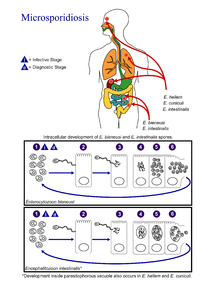Sporoplasm
This article needs more reliable medical references for verification or relies too heavily on primary sources. (January 2020) |  |

Sporoplasm is an infectious material present in the cytoplasm of various fungi-like organisms, such as members of class Microsporidia. Sporoplasm is defined as a mass of protoplasm that gives rise to or forms a spore. The protoplasmic body that is released as an infective amoebula from a cnidosporidian cyst.[1]
Mode of infection[edit]
It is injected to host cell through a coiled polar tube which acts as a spring-like tubular extrusion mechanism. It is mainly involved in the asexual cycle of the organism.
Reproduction[edit]
Inside the host cell, the sporoplasm multiplies to generate meronts, cells with loosely organized organelles enclosed in a simple plasma membrane.[2] Multiplication occurs either by merogony (binary fission) or schizogony (multiple fission) or plasmotomy (division of nucleus without relation to cytoplasm to produce multi-nucleated offspring).
References[edit]
- ^ "Definition of SPOROPLASM". www.merriam-webster.com. Retrieved 2019-12-28.
- ^ "MICROSPORIDIA". web.stanford.edu. Retrieved 2019-12-31.
